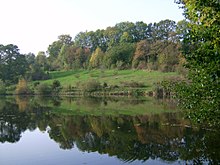Goppeln
|
Goppeln
Municipality Bannewitz
Coordinates: 50 ° 59 ′ 20 ″ N , 13 ° 45 ′ 36 ″ E
|
|
|---|---|
| Height : | 236 m above sea level NHN |
| Residents : | 805 (December 31, 2012) |
| Incorporation : | July 1, 1996 |
| Postal code : | 01728 |
| Area code : | 0351 |
|
Location of Goppeln in Bannewitz
|
|
Goppeln is a district of the Saxon community of Bannewitz in the district of Saxon Switzerland-Eastern Ore Mountains .
geography
Goppeln is located on the southern slopes of the Dresden Elbe valley and has a local structure characterized by agriculture. South of the village, the Gebergrund (from Slav. Javor , the maple) cuts about 50 m into the plateau.
In the 1990s, due to the preferred location on the outskirts of Dresden, new single-family houses were built on the western outskirts through suburbanization . In 2005, the federal motorway 17 running north-east of the town was built with the junction and motorway maintenance office “Dresden-Prohlis” and the Goppeln / Rippien state road 191 bypass .
In the course of the incorporation to Bannewitz in 1996, Goppeln received its current status as a village , to which, in addition to Goppeln itself, the districts of Golberode and Gaustritz also belong. Kauscha , which was also part of this village, has belonged to Dresden since 1999.
history
Historical data
Extract from the cultural history of Goppeln:
| 1286 | First documented mention as a guppil |
| 1288 | Margravine Elisabeth, widow of Margrave Heinrich the Illustrious, donated her possessions in Goppeln to the Altzelle monastery, plus patronage rights and blood courts. |
| 1307 | Leubnitzer monks successfully cultivated extensive hops. |
| 1370 | Some parts of Goppeln belonged to the Augustinian monastery Alten-Dresden after consultation with the abbot of the Altzelle monastery. |
| 1539 | Breakthrough of the Reformation |
| 1776 | Introduction of potato cultivation in Goppeln after the famine years of 1771 and 1772 |
| 1813 | On August 27, after the battle of Dresden, German troops marched south via Kauscha and Sobrigau. Persecution via Possendorf and Dippoldiswalde by French army units. Napoleon crossed Goppeln on August 29th. |
| 1890 | Resolution of the communities of Goppeln, Kauscha and Golberode to found a school community and build a school building |
| 19th century | Goppeln is known as a painter's village. |
| 1910 | Goppelner farmers and homeowners merge to form a water cooperative |
| 1912 | A gas line is being laid to Goppeln. |
| 1920 | Connection to the power grid |
| 1923 | Foundation of the Congregation of the Nazareth Sisters of St. Francis through Mother Augustina |
| 1929 | Inauguration of the newly built children's home of the Nazareth sisters |
| 1995 | Opening of the St. Clara nursing home of the Nazareth Sisters |
| 1996 | Incorporation after Bannewitz |
Development of the population
|
|
Place name forms
The name of the place Goppeln changed historically as follows:
- 1286: Guppil, Guppyl,
- 1288: Guppel,
- 1350: Cuppel, Gupil,
- 1445/47: Goppel and
- 1500: Goppellnn.
monastery
The mother house of the Nazareth Sisters of St. Francis , a Roman Catholic women's congregation founded by Augustina Schumacher .
During the GDR era, the sisters looked after a children's home in the complex , which was converted into the Catholic retirement and nursing home St. Clara in the 1990s . Cardinal Groër also found refuge here for a few months in 1998 . The monastery still offers space for seniors who want to end their old age in an idyllic place. It is known for its monastery café, which is widely used by the nuns who live there, but also by tourists and residents. The income is used to maintain the monastery and other charitable purposes.
Painter village
The place became known as a painter's village in the last decade of the 19th century. A group of young artists came together here in an artist colony . The Goppelner artists' colony was distinguished by its specialization in open-air painting and impressionism, and as the “Goppelner School” it became a household name in art history .
The Brücke painters Ernst Ludwig Kirchner and Max Pechstein also worked in Goppeln for a short time. Some of them then founded a new artist colony elsewhere or relocated to another.
Artist
- Carl Bantzer (1857-1941)
- Paul Baum (1859-1932)
- Walter Besig (1869–1950)
- Wilhelm Claudius (1854–1942)
- Georg Estler (1860–1954)
- Otto Fischer (1870-1947)
- Hermann Gattiker (1865–1950)
- Georg Gröne (1864–1935)
- Ernst Ludwig Kirchner (1880–1938)
- Oskar Kruse-Lietzenburg (1847-1919)
- Gotthardt Kuehl (1850–1915)
- Georg Müller-Breslau (1856-1911)
- Max Pechstein (1881–1955)
- Max Pietschmann (1865–1952)
- Wilhelm Georg Ritter (1850-1926)
- Sascha Schneider (1870-1927)
- Max Seliger (1865-1920)
- Robert Sterl (1867-1932)
- Hans Unger (1872–1936)
- Emil Voigtländer-Tetzner (1851–1908)
- Emilie Mediz-Pelikan (1861–1908)
- Karl Mediz (1868–1945)
literature
- Gerhard Wietek (Ed.): German artist colonies and artist locations. Thiemig, Munich 1976, ISBN 3-521-04061-5 .
Web links
- Goppeln in the Digital Historical Directory of Saxony
- Goppeln on www.bannewitz.de
Individual evidence
- ↑ Municipal administration Bannewitz: Presentation of the districts of Bannewitz
- ^ Bannewitz community: Goppeln district. Bannewitz community, accessed on November 7, 2017 .
- ↑ a b The Historical Directory of Saxony. Institute for Saxon History and Folklore (ISGV), accessed on November 6, 2017 .
- ↑ Municipal administration Bannewitz: Presentation of the districts of Bannewitz






